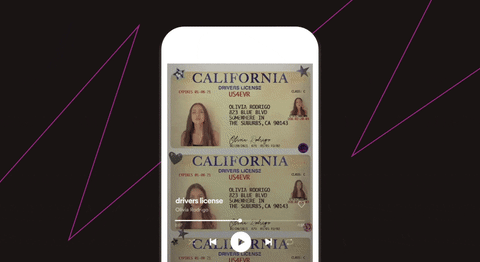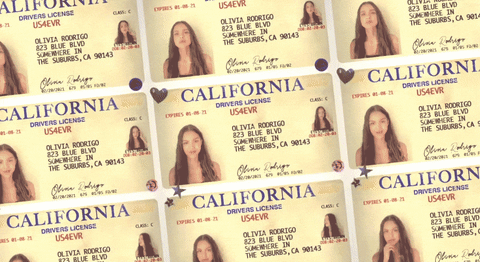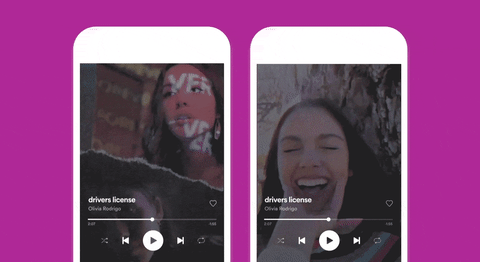From Concept to Canvas: Olivia Rodrigo’s “drivers license”

The biggest song in the world features one of the coolest Canvases on Spotify. We talk to Olivia Rodrigo’s creative team about making the perfect visual accompaniment for her breakup anthem.
Right now, Olivia Rodrigo is in the driver’s seat and the whole world is along for the ride. As of this writing, the 17-year-old singer-songwriter’s single “drivers license” has been No. 1 on the Global Weekly Top Songs Chart for three weeks in a row and has set the record for the most streams for a song in a week on Spotify. The song also sits atop Spotify’s United States Top 50 with over 2 million daily plays and is No. 1 on the Global Top 50 with over 8 million daily plays. This is all after debuting at No. 1 on the Billboard Hot 100 singles chart and setting the record for the most streams in a day for a non-holiday song.
The single’s success is due to a number of factors: first and foremost, it’s a heartfelt, relatable, and catchy pop song about young love and loss; then there’s Rodrigo’s preexisting fanbase as a Disney starlet (she plays Nini Salazar-Roberts in “High School Musical: The Musical: The Series”); add to that the song’s virality on social media; co-signs from Taylor Swift and Billie Eilish; fan theories about the story behind its lyrics; and you’ve got the recipe for the first bona fide mega-hit of 2021.
When you listen to the track on the Spotify app you’ll notice the looping image of three vintage-looking California driver’s licenses stacked on top of each other, each with animated images of Rodrigo looking alternately sad, strong, pensive, and happy — this is the Canvas for “drivers license.” Conceived by Rodrigo herself, the Canvas is a hit too, with over 243,000 total Instagram shares in the first week of its release (Jan. 8 to Jan.15) and more than 50 million views in the first three weeks. Ned Monahan, Spotify’s Head of Global Hits, knows that breakout successes like this one only happen once in a blue moon. “These sorts of lightning-in-a-bottle moments are rare, but the stars really aligned for ‘drivers license,’” he explains. “It’s a truly great song that’s instantly engaging, touching on universal feelings of heartbreak and suburban angst. The Canvas is a visual extension of the song’s themes, giving fans another way of contextualizing Olivia’s vision and relatable experiences — so it makes sense that it’s been well-received!”
To bring her vision for the Canvas to life, Rodrigo and Interscope/Geffen worked with art director Dina Hovsepian and designer Tim Barsten. “What we were trying to capture was a vintage-looking license, says Hovsepian, explaining her approach to the design. “I used lots of layers of scratchy filters to create the washed-out feel over her photos and to create the faded text.” (And yes, she confirms, “It’s her real b-day on the license.”) To further understand the inspiration and execution behind the Canvas, Spotify for Artists asked Barsten, who designed and animated the Canvas, about the process.
Spotify for Artists: How big of a role did Olivia play in the creative process for this Canvas? What was her input?
Tim Barsten: I have to give all the creative direction credit to Olivia [Rodrigo]. The label provided the artwork and the original driver’s license design she used for her merch for the single, and Olivia provided some shots of herself for the Canvas with the note that she would like to replace the images on the driver’s license with the shots she sent. She said “Think: Harry Potter, talking portraits” and I knew exactly what she meant. I then took all the assets into [Adobe] After Effects and designed what you see today.

Olivia Rodrigo's Harry Potter-inspired driver's licenses
Talk about interpreting the song and its lyrics visually for the Canvas, there are six looping images in the three licenses in the frame of the Canvas, were those images created specifically for this? What was the direction of the shoot for them and what emotions/moods were you trying to capture?
In order to capture the concept of the song, Olivia wanted to showcase all of the different stages of a relationship that has come to an end. From heartbreak to forgiveness, to finally getting back to being happy again, she wanted all of the stages represented in the six different images on the three driver’s licenses for the Canvas of the song.
How did you think about how the Canvas and single artwork should be different or work together?
I love that this Canvas is different from the concept for the [single] artwork and music video — it acts almost as a supplemental piece of creative for the song that tells the story in a different way. Because the Canvas concept was different from the art and video but still needed to feel within the same world, I incorporated subtle elements of the music video and single art to help connect them visually. I was able to do that by overlaying some light purple flares in the background and overlaid grain to replicate the music video which was shot on film. From the artwork, I was inspired by the torn paper, grungier feel and applied vintage coloring, and added a slight degradation over the entire Canvas to make it feel a little more retro.
How long did it take for you to go from concept to Canvas? Were there many revisions?
We started with the first concept during the second week of December [2020]. We went back and forth over the next few weeks with different concepts and versions before ultimately settling on the final version you see today. In the end, the original concept from that second week of December is the one we ended up going with!

Early alternate versions of the "drivers license" Canvas
Which ideas were left on the cutting room floor?
We had a few different concepts we were working through. On one of them, I took the original artwork and created a stagnant image in the vertical canvas format. I then separated the different layers and applied different types of grains, dust, flares, scan lines, and film mattes to the separated layers to give each layer its own individual movement. In the end, the concept you see now was the most compelling.
How does it feel to know that your work has been seen or shared by millions of fans at this point? Did you notice all the Canvas shares to Instagram Stories?
It feels so cool to have worked on something that has reached the eyes of millions of people on both Spotify and Instagram. I’ve loved seeing it shared all over the world!
Spotify for Artists helps you to develop the fanbase you need to reach your goals.